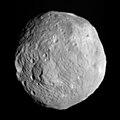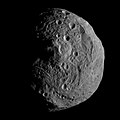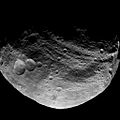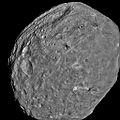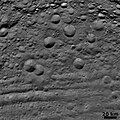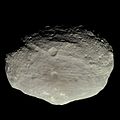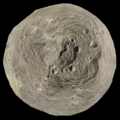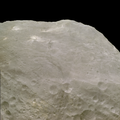4 Vesta
Synodic rotation period | 0.2226 d (5.342 h)[6][13] | |
Equatorial rotation velocity | 93.1 m/s[c] | |
|---|---|---|
| 29° | ||
North pole right ascension | 20h 32m[d] | |
North pole declination | 48°[d] | |
| 0.423[15] | ||
| Temperature | min: 75 K (−198 °C) max: 250 K (−23 °C)[16] | |
| V[6][17] | ||
| 5.1[18] to 8.48 | ||
| 3.20[6][15] | ||
| 0.70″ to 0.22″ | ||
Vesta (minor-planet designation: 4 Vesta) is one of the largest objects in the asteroid belt, with a mean diameter of 525 kilometres (326 mi).[10] It was discovered by the German astronomer Heinrich Wilhelm Matthias Olbers on 29 March 1807[6] and is named after Vesta, the virgin goddess of home and hearth from Roman mythology.[19]
Vesta is thought to be the second-largest asteroid, both by mass and by volume, after the dwarf planet Ceres.[20][21][22] Measurements give it a nominal volume only slightly larger than that of Pallas (about 5% greater), but it is 25% to 30% more massive. It constitutes an estimated 9% of the mass of the asteroid belt.[23] Vesta is the only known remaining rocky protoplanet (with a differentiated interior) of the kind that formed the terrestrial planets.[24][25][26] Numerous fragments of Vesta were ejected by collisions one and two billion years ago that left two enormous craters occupying much of Vesta's southern hemisphere.[27][28] Debris from these events has fallen to Earth as howardite–eucrite–diogenite (HED) meteorites, which have been a rich source of information about Vesta.[29][30][31]
Vesta is the
NASA's Dawn spacecraft entered orbit around Vesta on 16 July 2011 for a one-year exploration and left the orbit of Vesta on 5 September 2012[33] en route to its final destination, Ceres. Researchers continue to examine data collected by Dawn for additional insights into the formation and history of Vesta.[34][35]
History
Discovery
Name and symbol
Vesta was the fourth asteroid to be discovered, hence the number 4 in its formal designation. The name Vesta, or national variants thereof, is in international use with two exceptions: Greece and China. In Greek, the name adopted was the Hellenic equivalent of Vesta, Hestia (4 Εστία); in English, that name is used for 46 Hestia (Greeks use the name "Hestia" for both, with the minor-planet numbers used for disambiguation). In Chinese, Vesta is called the 'hearth-god(dess) star', 灶神星 zàoshénxīng, naming the asteroid for Vesta's role, similar to the Chinese names of Uranus, Neptune, and Pluto.[f]
Upon its discovery, Vesta was, like Ceres, Pallas, and Juno before it, classified as a planet and given a planetary symbol. The symbol represented the altar of Vesta with its sacred fire and was designed by Gauss.[41][42] In Gauss's conception, now obsolete, this was drawn ![]() : his form is in the pipeline for Unicode 17.0 as U+1F777 .[43][44][g] The asteroid symbols were gradually retired from astronomical use after 1852, but the symbols for the first four asteroids were resurrected for astrology in the 1970s. The abbreviated modern astrological variant of the Vesta symbol is
: his form is in the pipeline for Unicode 17.0 as U+1F777 .[43][44][g] The asteroid symbols were gradually retired from astronomical use after 1852, but the symbols for the first four asteroids were resurrected for astrology in the 1970s. The abbreviated modern astrological variant of the Vesta symbol is ![]() (U+26B6 ⚶).[43][h]
(U+26B6 ⚶).[43][h]
After the discovery of Vesta, no further objects were discovered for 38 years, and during this time the Solar System was thought to have eleven planets.[49] However, in 1845, new asteroids started being discovered at a rapid pace, and by 1851 there were fifteen, each with its own symbol, in addition to the eight major planets (Neptune had been discovered in 1846). It soon became clear that it would be impractical to continue inventing new planetary symbols indefinitely, and some of the existing ones proved difficult to draw quickly. That year, the problem was addressed by Benjamin Apthorp Gould, who suggested numbering asteroids in their order of discovery, and placing this number in a disk (circle) as the generic symbol of an asteroid. Thus, the fourth asteroid, Vesta, acquired the generic symbol ④. This was soon coupled with the name into an official number–name designation, ④ Vesta, as the number of minor planets increased. By 1858, the circle had been simplified to parentheses, (4) Vesta, which were easier to typeset. Other punctuation, such as 4) Vesta and 4, Vesta, was also used, but had more or less completely died out by 1949.[50]
Early measurements
Photometric observations of Vesta were made at the
Early estimates of the diameter of Vesta ranged from 383 kilometres (238 mi) in 1825, to 444 km (276 mi).
Vesta became the first asteroid to have its mass determined. Every 18 years, the asteroid
Orbit
Vesta orbits the Sun between Mars and Jupiter, within the asteroid belt, with a period of 3.6 Earth years,[6] specifically in the inner asteroid belt, interior to the Kirkwood gap at 2.50 AU. Its orbit is moderately inclined (i = 7.1°, compared to 7° for Mercury and 17° for Pluto) and moderately eccentric (e = 0.09, about the same as for Mars).[6]
True orbital resonances between asteroids are considered unlikely; due to their small masses relative to their large separations, such relationships should be very rare.[58] Nevertheless, Vesta is able to capture other asteroids into temporary 1:1 resonant orbital relationships (for periods up to 2 million years or more); about forty such objects have been identified.[59] Decameter-sized objects detected in the vicinity of Vesta by Dawn may be such quasi-satellites rather than proper satellites.[59]
Rotation
Vesta's rotation is relatively fast for an asteroid (5.342 h) and
Coordinate systems
Two longitudinal coordinate systems are used for Vesta, with
Physical characteristics
Graphs are unavailable due to technical issues. There is more info on
Enceladus (Saturn II), are over twice and less than half of Vesta's mass.Vesta is the second most massive body in the asteroid belt, although it is only 28% as massive as Ceres, the most massive body.[64][23] Vesta is however the most massive body that formed in the asteroid belt, as Ceres is believed to have formed between Jupiter and Saturn. Vesta's density is lower than those of the four terrestrial planets but is higher than those of most asteroids, as well as all of the moons in the Solar System except Io. Vesta's surface area is about the same as the land area of Pakistan, Venezuela, Tanzania, or Nigeria; slightly under 900,000 square kilometres (350,000 sq mi; 90,000,000 ha; 220,000,000 acres). It has a differentiated interior.[24] Vesta is only slightly larger (525.4±0.2 km[10]) than 2 Pallas (512±3 km) in mean diameter,[65] but is about 25% more massive. Vesta's shape is close to a gravitationally relaxed oblate spheroid,[60] but the large concavity and protrusion at the southern pole (see 'Surface features' below) combined with a mass less than 5×1020 kg precluded Vesta from automatically being considered a dwarf planet under International Astronomical Union (IAU) Resolution XXVI 5.[66] A 2012 analysis of Vesta's shape[67] and gravity field using data gathered by the Dawn spacecraft has shown that Vesta is currently not in hydrostatic equilibrium.[10][68]
Temperatures on the surface have been estimated to lie between about −20 °C (253 K) with the perihelion, although details vary somewhat with the seasons.[16]
Surface featuresBefore the arrival of the Dawn spacecraft, some Vestan surface features had already been resolved using the Hubble Space Telescope and ground-based telescopes (e.g., the Keck Observatory).[69] The arrival of Dawn in July 2011 revealed the complex surface of Vesta in detail.[70] Veneneia and Rheasilvia impacts are purple (the Saturnalia Fossae Formation, in the north)[72] and light cyan (the Divalia Fossae Formation, equatorial),[71] respectively; the Rheasilvia impact basin interior (in the south) is dark blue, and neighboring areas of Rheasilvia ejecta (including an area within Veneneia) are light purple-blue;[73][74] areas modified by more recent impacts or mass wasting are yellow/orange or green, respectively.Rheasilvia and Veneneia craters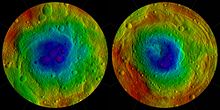 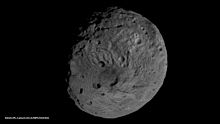 The most prominent of these surface features are two enormous craters, the 500-kilometre (311 mi)-wide Rheasilvia crater, centered near the south pole, and the 400 km (249 mi) wide Veneneia crater. The Rheasilvia crater is younger and overlies the Veneneia crater. The large peak at the center of Rheasilvia is 20 to 25 km (12–16 mi) high and 180 km (112 mi) wide,[75] and is possibly a result of a planetary-scale impact.[78] Other cratersSeveral old, degraded craters rival Rheasilvia and Veneneia in size, although none are quite so large. They include Feralia Planitia, shown at right, which is 270 km (168 mi) across.[79] More-recent, sharper craters range up to 158 km (98 mi) Varronilla and 196 km (122 mi) Postumia.[80] Sometimes, dust fills up these craters, creating a phenomenon called dust ponds. They are a phenomenon where pockets of Dust are seen in Celestial bodies without a significant atmosphere. These are smooth deposits of dust accumulated in depressions on the surface of the body (like craters), contrasting from the Rocky terrain around them. [81] On the surface of Vesta, we have identified both type 1 (formed from impact melt) and type 2 (electrostatically made) dust ponds within 0˚–30°N/S, that is, Equatorial region. 10 craters have been identified with such formations.[82] "Snowman craters"The "snowman craters" are a group of three adjacent craters in Vesta's northern hemisphere. Their official names, from largest to smallest (west to east), are Marcia, Calpurnia, and Minucia. Marcia is the youngest and cross-cuts Calpurnia. Minucia is the oldest.[71] "Snowman" craters by Dawn from 5,200 km (3,200 mi) in 2011 TroughsThe majority of the equatorial region of Vesta is sculpted by a series of parallel troughs. The largest is named longest chasms in the Solar System, nearly as long as Ithaca Chasma on Tethys. The troughs may be graben that formed after another asteroid collided with Vesta, a process that can happen only in a body that, like Vesta, is differentiated.[83] Vesta's differentiation is one of the reasons why scientists consider it a protoplanet.[84] Alternatively, it is proposed that the troughs may be radial sculptures created by secondary cratering from Rheasilvia. [85]
Surface compositionCompositional information from the visible and infrared spectrometer (VIR), gamma-ray and neutron detector (GRaND), and framing camera (FC), all indicate that the majority of the surface composition of Vesta is consistent with the composition of the howardite, eucrite, and diogenite meteorites.[86][87][88] The Rheasilvia region is richest in diogenite, consistent with the Rheasilvia-forming impact excavating material from deeper within Vesta. The presence of olivine within the Rheasilvia region would also be consistent with excavation of mantle material. However, olivine has only been detected in localized regions of the northern hemisphere, not within Rheasilvia.[34] The origin of this olivine is currently unknown.[citation needed] Features associated with volatilesPitted terrain has been observed in four craters on Vesta: Marcia, Cornelia, Numisia and Licinia.[89] The formation of the pitted terrain is proposed to be degassing of impact-heated volatile-bearing material. Along with the pitted terrain, curvilinear gullies are found in Marcia and Cornelia craters. The curvilinear gullies end in lobate deposits, which are sometimes covered by pitted terrain, and are proposed to form by the transient flow of liquid water after buried deposits of ice were melted by the heat of the impacts.[72] Hydrated materials have also been detected, many of which are associated with areas of dark material.[90] Consequently, dark material is thought to be largely composed of carbonaceous chondrite, which was deposited on the surface by impacts. Carbonaceous chondrites are comparatively rich in mineralogically bound OH.[88] GeologyA large collection of potential samples from Vesta is accessible to scientists, in the form of over 1200 HED meteorites (Vestan achondrites), giving insight into Vesta's geologic history and structure. NASA Infrared Telescope Facility (NASA IRTF) studies of asteroid (237442) 1999 TA10 suggest that it originated from deeper within Vesta than the HED meteorites.[25] Vesta is thought to consist of a metallic iron–nickel core 214–226 km in diameter,[10] an overlying rocky olivine mantle, with a surface crust. From the first appearance of calcium–aluminium-rich inclusions (the first solid matter in the Solar System, forming about 4.567 billion years ago), a likely time line is as follows:[91][92][93][94][95]
Vesta is the only known intact asteroid that has been resurfaced in this manner. Because of this, some scientists refer to Vesta as a protoplanet.
On the basis of the sizes of V-type asteroids (thought to be pieces of Vesta's crust ejected during large impacts), and the depth of Rheasilvia crater (see below), the crust is thought to be roughly 10 kilometres (6 mi) thick.[98] Findings from the Dawn spacecraft have found evidence that the troughs that wrap around Vesta could be graben formed by impact-induced faulting (see Troughs section above), meaning that Vesta has more complex geology than other asteroids. Vesta's differentiated interior implies that it was in hydrostatic equilibrium and thus a dwarf planet in the past, but it is not today.[75] The impacts that created the Rheasilvia and Veneneia craters occurred when Vesta was no longer warm and plastic enough to return to an equilibrium shape, distorting its once rounded shape and prohibiting it from being classified as a dwarf planet today.[citation needed] RegolithVesta's surface is covered by brecciation and subsequent mixing of bright and dark components.[99] The dark component is probably due to the infall of carbonaceous material, whereas the bright component is the original Vesta basaltic soil.[100]
FragmentsSome small Solar System bodies are suspected to be fragments of Vesta caused by impacts. The Vestian asteroids and HED meteorites are examples. The V-type asteroid 1929 Kollaa has been determined to have a composition akin to cumulate eucrite meteorites, indicating its origin deep within Vesta's crust.[30] Vesta is currently one of only eight identified Exploration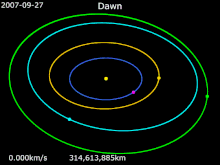 Dawn · Earth · Mars · 4 Vesta · 1 Ceres  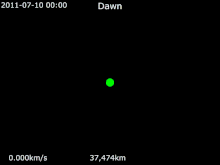 Dawn · 4 Vesta In 1981, a proposal for an asteroid mission was submitted to the Vesta mission, developed in cooperation with European countries for realisation in 1991–1994 but canceled due to the dissolution of the Soviet Union .
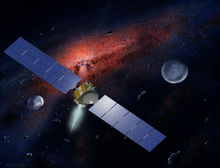 In the early 1990s, NASA initiated the Discovery Program, which was intended to be a series of low-cost scientific missions. In 1996, the program's study team recommended a mission to explore the asteroid belt using a spacecraft with an ion engine as a high priority. Funding for this program remained problematic for several years, but by 2004 the Dawn vehicle had passed its critical design review[103] and construction proceeded.[citation needed] It launched on 27 September 2007 as the first space mission to Vesta. On 3 May 2011, Dawn acquired its first targeting image 1.2 million kilometers from Vesta.[104] On 16 July 2011, NASA confirmed that it received telemetry from Dawn indicating that the spacecraft successfully entered Vesta's orbit.[105] It was scheduled to orbit Vesta for one year, until July 2012.[106] Dawn's arrival coincided with late summer in the southern hemisphere of Vesta, with the large crater at Vesta's south pole (Rheasilvia) in sunlight. Because a season on Vesta lasts eleven months, the northern hemisphere, including anticipated compression fractures opposite the crater, would become visible to Dawn's cameras before it left orbit.[107] Dawn left orbit around Vesta on 4 September 2012 11:26 p.m. PDT to travel to Ceres.[108] NASA/DLR released imagery and summary information from a survey orbit, two high-altitude orbits (60–70 m/pixel) and a low-altitude mapping orbit (20 m/pixel), including digital terrain models, videos and atlases.[109][110][111][112][113][114] Scientists also used Dawn to calculate Vesta's precise mass and gravity field. The subsequent determination of the J2 component yielded a core diameter estimate of about 220 km assuming a crustal density similar to that of the HED.[109] Dawn data can be accessed by the public at the UCLA website.[115]
Observations from Earth orbit
Observations from DawnVesta comes into view as the Dawn spacecraft approaches and enters orbit:
True-color imagesDetailed images retrieved during the high-altitude (60–70 m/pixel) and low-altitude (~20 m/pixel) mapping orbits are available on the Dawn Mission website of JPL/NASA.[117] VisibilityIts size and unusually bright surface make Vesta the brightest asteroid, and it is occasionally visible to the perihelion were only a few weeks apart.[119] It was brighter still at its 22 June 2018 opposition, reaching a magnitude of +5.3.[120]
Less favorable oppositions during late autumn 2008 in the conjunction with the Sun, Vesta will have a magnitude around +8.5; thus from a pollution-free sky it can be observed with binoculars even at elongations much smaller than near opposition.[121]
2010–2011In 2010, Vesta reached opposition in the naked eye. Under perfect dark sky conditions where all light pollution is absent it might be visible to an experienced observer without the use of a telescope or binoculars. Vesta came to opposition again on 5 August 2011, in the constellation of Capricornus at about magnitude 5.6.[122][123]
2012–2013Vesta was at opposition again on 9 December 2012. 2014 Ceres and Vesta came within one degree of each other in the night sky in July 2014.[125] See also
Notes
References
Bibliography
External linksWikimedia Commons has media related to Vesta (asteroid).
| |||||||||||||||||

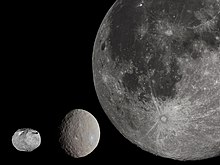
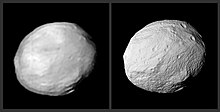




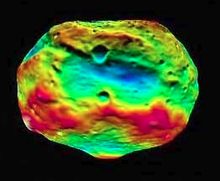

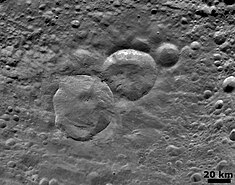


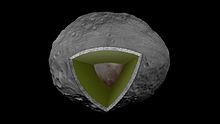




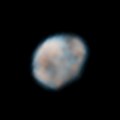
![The 2006 IAU draft proposal on the definition of a planet listed Vesta as a candidate.[116] Vesta is shown fourth from the left along the bottom row.](http://upload.wikimedia.org/wikipedia/commons/thumb/7/72/Iau_dozen.jpg/120px-Iau_dozen.jpg)

